Circassian on the Russian service
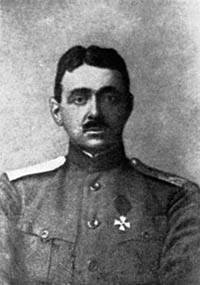 In the spring of 1922, the leaders of the Cheka and the Soviet military intelligence began to receive regularly from foreign residents and agents embedded in emigrant circles reports on the preparation and possible soon landing of the recently departed Wrangel army in the Kuban and North Caucasus.
In the spring of 1922, the leaders of the Cheka and the Soviet military intelligence began to receive regularly from foreign residents and agents embedded in emigrant circles reports on the preparation and possible soon landing of the recently departed Wrangel army in the Kuban and North Caucasus.Information about the place, time and number of troops varied. But at the request of who will lead such a risky and bold enterprise, all sources called the same person - General Ulagay.
THE CASTING of the ancient Shapsug princes of the father and the barons von Alimert was born on October 31 1875, either in the village of Klyuchevskaya (now the city of Hot Key), into whose Cossacks were later enrolled, or in Chuguev, where at the time of the birth of the blatant the boy was serving his parent.
The father of the future General Islam-Giray Ulagay, who after baptism, took the name of Georgii Viktorovich, from the age of sixteen served the Russian crown. In July, 1851, he entered as a non-commissioned officer in the 14 Black Sea Battalion, and in the same year, participating in battles against the Highlanders, he earned the Insignia of the Military Order of St. George 4, for Muslims, who had the serial number “45”. The Russian-Turkish war of 1877 – 1878 was met by a lieutenant colonel. Bravely fought with the Turks and heroically fell at the capture of the city of Turnov. At the behest of Emperor Alexander II, he was posthumously promoted to colonel and buried in the monastery of St. Nicholas near Mount Helena, where his ashes lie to this day.
After the death of his father, the same age brothers Anatoly and Sergey were brought up by their mother. But this circumstance did not affect their character and inclinations at all - both sons of the hero of the Balkan war chose military service as a matter of life, devoting themselves to it without a trace.
Sergey Ulagay graduated from the Voronezh Mikhailovsky Cadet Corps in 1895 on the 1 year, two years later - the Nikolaev Cavalry School, formerly a school of guards sub-ensigns and cavalry juniors, from which, by the way, M.Yu. Lermontov graduated from 1834 year.
The twenty-two-year-old cornet was assigned to the 1 th Khopersky Cossack regiment, from which it was soon transferred to the Kuban Cossack Division, which had been stationed near Warsaw. Riders of the division, among other things, made up the convoy of the commander of the Warsaw Military District, and the officers performed at various army cavalry competitions.
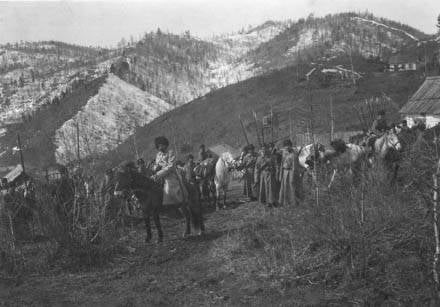 Highlander Ulagay, who learned to stay in the saddle earlier than walking, was rightly considered the best rider and did not miss any races. From them he invariably returned with prizes, arranging stormy revels for colleagues. But one day a black cloud arrived - on the Moscow hippodrome, his older brother Anatoly, an officer of the 2 Hopersky Cossack regiment, died in his eyes: the horse could not overcome the barrier and collapsed to the ground from all over.
Highlander Ulagay, who learned to stay in the saddle earlier than walking, was rightly considered the best rider and did not miss any races. From them he invariably returned with prizes, arranging stormy revels for colleagues. But one day a black cloud arrived - on the Moscow hippodrome, his older brother Anatoly, an officer of the 2 Hopersky Cossack regiment, died in his eyes: the horse could not overcome the barrier and collapsed to the ground from all over.For almost a year Sergey Georgievich did not find a place for himself. And it is not known how the loss of his beloved brother eventually affected the psyche of the young officer, do not start the Russo-Japanese war in the Far East.
Vacation to war
The KUBAN Cossack Division, like most military units of the western military districts, was not part of the active army that was deployed in the vastness of Manchuria. That, however, did not prevent his officers in full force to file a report with a request to send them to the front. None of them was satisfied: in the mobilized regiments and divisions all the vacancies were occupied.
But if the colleagues of Ulagai shed their anger at the military bureaucracy in Warsaw restaurants, then the gloomy centurion of 31 in March 1904 of the year simply took a two-month vacation "for domestic reasons." And April 19 appeared ... in the field headquarters of the Manchurian army, presented in all its glory to its commander.
It is not known what words and arguments Sergey Georgievich found in a conversation with General Kuropatkin, but on the same day he was seconded "for the whole time of hostilities or until death" to the 1-th Argun regiment of the Transbaikalian Cossack army. In less than a month, he was seriously wounded.
In the official summary for May 14, this was reported as follows: “In the morning of May 12, a large Japanese detachment attempted an offensive on the main Lyaoyan road by force of an infantry battalion and cavalry squadron, but soon the Cossacks were forced to stop and then retreat back to Thumenza. In the Aikhe river valley, the Japanese took a position on the heights near the village of Dapu and met the Cossacks hanging from their shoulders with strong fire. The exchange of fire continued from 10 to 4 in the afternoon hours, and the Japanese cavalry tried to cover the right flank of the Cossacks and cut off their escape route, but this was not possible. In the course of the battle, the Kuban Cossack Division, the centurion Ulagay and the 8 of the Argun Cossacks, were wounded, and the 2 of the Cossack were wounded. ”
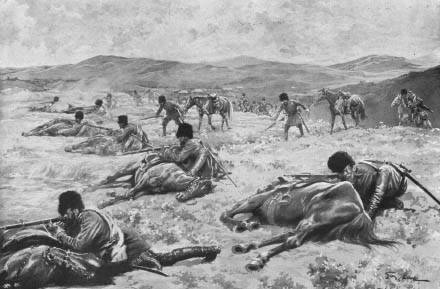 A Japanese bullet went right through Sergei Georgievich’s chest. The injury was not an easy one, but despite this, he refused to evacuate. And soon he received congratulations from the Arguns who fell in love and already considered him: to the brave centurion right on the front, they were handed the Insignia of the Order of St. Anne 4 degree - a piece with the inscription "For Bravery" engraved on the hilt and decorated with red and white lingerie.
A Japanese bullet went right through Sergei Georgievich’s chest. The injury was not an easy one, but despite this, he refused to evacuate. And soon he received congratulations from the Arguns who fell in love and already considered him: to the brave centurion right on the front, they were handed the Insignia of the Order of St. Anne 4 degree - a piece with the inscription "For Bravery" engraved on the hilt and decorated with red and white lingerie.She became the first Ulagay combat reward, but not the last. He managed to distinguish himself in the raids of General Mishchenko's equestrian groups, he famously chopped along with General Renenkampf's cavalrymen. And by the end of the war, in addition to Anninsky arms, his uniform decorated the Order of St. Anne 3-th degree, St. Stanislaus 3-th and 2-th degree with swords, St. Vladimir 4-th degree with swords and bow.
So Sergey Georgievich returned to his native division as a distinguished military officer, rumors about his valor ran far ahead of him ...
From war to war
POSITIONED peaceful everyday life. In addition to performing direct official duties, he headed the division's cash desk, headed the garrison court of officer honor. Both of these posts were elective, and the fact of the election of Sergey Georgievich to them once again underlines the authority and trust that he enjoyed from his colleagues.
In general, Ulagay was a flawless officer in all respects. The commander of the Kuban Cossack Division, Colonel A. K. Perepelovsky, in the summer of 1908, gave him the following description: “I treat the case honestly. The service is loyal, demanding and persistent, has no attraction for economic positions. He knows and loves the drill. Physically healthy, well-mannered, developed and with good abilities. Morally impeccable. Sober, has a hard, energetic, but slightly hot-tempered character. By the Cossacks strict, but fair, with his comrades live in great agreement. Dashing rider, everything can teach the lower ranks, not only by story, but also by personal example. "
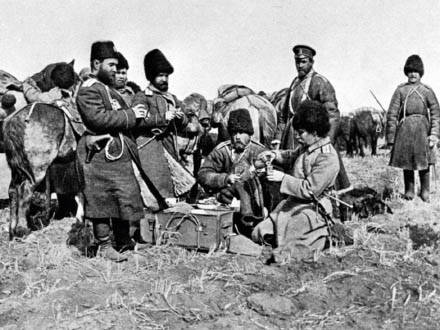 For all this time, Sergey Georgievich took his vacation only once, and then not on his own will. In January, 1909 had inflamed a wound received in Manchuria, and underwhelms were ordered to go to European resorts, where he stayed until the end of spring. And when he returned, again plunged into the service.
For all this time, Sergey Georgievich took his vacation only once, and then not on his own will. In January, 1909 had inflamed a wound received in Manchuria, and underwhelms were ordered to go to European resorts, where he stayed until the end of spring. And when he returned, again plunged into the service.He never got a family, which, however, was in the order of things for officers of the Russian army at that time. The future general and commander of Ulagay on the margins of World War Peter Nikolayevich Krasnov wrote about this feature of the biography of many honest servants to the throne and the Fatherland: “The military exercises, concerns about the content and equipment of subordinates, tactical exercises, reviews, live firing, training camps and maneuvers were taken away from officers all the time. There was no personal life - there was one regimental family, living on the same common interests of the regiment. ”
In October, 1913, Sergey Georgievich took over command over the 2 of the hundreds of native divisions. At its head, and flew dashing cavalry gallop in the First World War ...
Seconded
The Kuban Cossack Division did not often have to clash with the enemy - mainly its horsemen carried ordinary and convoy service at the army headquarters and corps headquarters. Only a few months after the start of the war, I settle down, already made in the captains, was fortunate enough to lead a hundred into a real cavalry attack: November 9, 11 near the village of Radogosh, his Cossacks swept away a squadron of Prussia hussars, for which Sergey Georgievich was awarded the Order of St. Anna 1914 .
And still, the security service of the high staff officers did not satisfy the hot centurion much. He rushed into the ordinary cavalry unit, where clashes with the enemy were a daily occurrence.
After lengthy troubles, I was able to achieve secondment to the 1-th Linear General Veliyamin's regiment, which was part of the 2-th Consolidated Cossack Division, which was promoted to a considerable degree by the Chief Major-General P. N. Krasnov, who knew Sergey Georgievich well in Russian- Japanese He immediately warned the officer who had arrived at his disposal that there was no permanent position for him; accordingly, the улsoulful salary would receive only for a military rank. In reply Ulagay just smiled broadly ...
In the courtyard stood June 1915 of the year. Cossack regiments during this period served as a kind of cavalry veil, not allowing the advancing enemy to torment the rear guards of the Russian army, which was slowly retreating to the east.
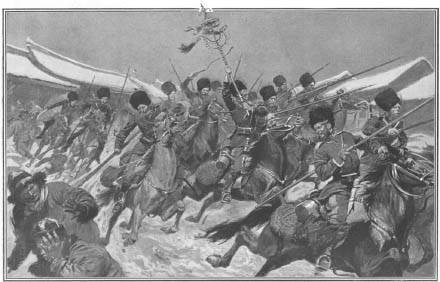 Work them enough. And here the experience of semi-partisan actions, acquired We settle back in Manchuria, came in handy. He was more and more often appointed to be the commander of small cavalry units that were solving independent tasks. And soon the rumor about the glorious affairs of the seconded officer went for a walk around the division.
Work them enough. And here the experience of semi-partisan actions, acquired We settle back in Manchuria, came in handy. He was more and more often appointed to be the commander of small cavalry units that were solving independent tasks. And soon the rumor about the glorious affairs of the seconded officer went for a walk around the division.Commanding two hundreds of lineans, Sergey Georgievich successfully ambushed the village of Chukchitsy, capturing the German Uhlans around 80. Near the village of Savin Posad with three hundred Cossacks hacked down two companies of the German infantry, taking 8 machine guns as trophies. Having learned that in the village of Kharitonovka, the Austrian squadron and the German battery stopped for the night, in the early morning, as soon as the enemy started off and was drawn into the thicket, he arranged a dashing raid on them. The Austrians were scattered in the forest with large losses for them, all six German guns were drowned in a swamp. For our part, only two hundred Kuban members took part in the case. But they led Ulyay! But his main exploits were ahead ...
1915 year in stories The First World War is considered to be "the year of the great retreat of the Russian army." By and large this is true. But, departing under the pressure of a numerically superior enemy, our regiments and brigades managed to successfully counterattack, inflicting significant losses on enemy units.
During one of the counterattacks between the Austrians and the Russian 4 Corps, September 17, a stubborn battle ensued. The front has cracked. And then, having no infantry units around them, four hundred Cossack-lineans, led by We settle, under foot machine gun fire on foot with checkers naked, rushed towards the Austrians, handled them and fled. For that fight, Sergey Georgievich was awarded a saber with black and orange lanyard, becoming one of the few officers in the Russian army who possessed both Anninsky and St. George weapons - awards awarded exclusively for personal courage.
And in the next year, 1916, Ulagay became the St. George Knight. The most honorable of the military orders he received during the famous Lutsk (Brusilovsky) breakthrough, because, "commanding three hundred and machine-gun platoon regiments, under strong artillery, rifle and machine-gun fire, crossed the three arms of the Stokhod river near the village of Rudka-Chervishche and entrenched on the enemy's shore in front of the enemy’s wire obstacles, he immediately opened fire on him. This dashing crossing contributed a lot to the advancement of the infantry and gave it the opportunity to gain a foothold on the enemy shore. ”
Interesting fact: by December 1916, in the 1 Linean General of Velyaminov, the Cossack regiment, which actually did not get out of the fighting for two and a half years of the war, the Order of St. George 4 degree was awarded to only six officers, including the commander of the Colonel G. G. Yevseyev .
Seventh was seconded to the regiment of the military foreman (lieutenant colonel) Ulagay.
In troubled times
4 MARCH 1917 was awarded the rank of colonel to Sergey Georgievich. And on May 10, he finally got a permanent position - he was appointed commander of the 2 Zaporozhye Cossack regiment. In late August, his unit in full support of the Kornilov revolt, after which Ulagay was removed from command and imprisoned. There he met the news of the seizure of power in the capital by the Bolsheviks. Understanding perfectly well that now his case could easily end with a death sentence, Sergei Georgievich in November escaped from his arrest in the Kuban. There he became one of the initiators and most active members of the White movement.
At first, the Cossacks, who returned to their native villages after four years at the front line, were in no hurry to sign up for fighters with the Soviet authorities. For a month, I was barely able to recruit a company of plastuses, which were received mainly by officers of the Cossack regiments, who knew their new commander well in their fierce attacks and raids on the German front.
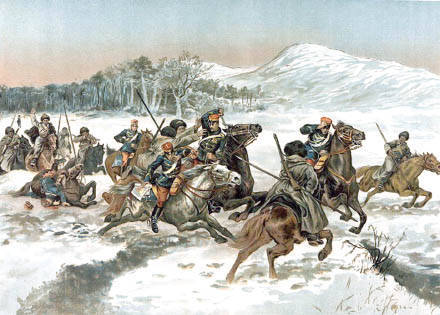 The situation with other recruiters in the white Kuban army was no better. And although the chieftain of the Kuban Cossack troops, AP P. Filimonov, wanted to see Ulagai as commander, Sergei Georgievich refused the offer: to command an army that does not exist, he did not know how. Yes, and did not want ...
The situation with other recruiters in the white Kuban army was no better. And although the chieftain of the Kuban Cossack troops, AP P. Filimonov, wanted to see Ulagai as commander, Sergei Georgievich refused the offer: to command an army that does not exist, he did not know how. Yes, and did not want ...17 February 1918 of the year in a stubborn battle near the village of Vyselki The Kuban army was defeated by the Red Guard units. Her remains were forced to leave Yekaterinodar and retreat to the mountains of the North Caucasus. For almost a month, the Kuban people licked up their wounds and saved their strength, until in the second half of March they had joined the Novo-Dmitrievskaya stanitsa to join them with the Volunteer army of General Kornilov, who marched on Ekaterinodar.
The Plastunsky officer battalion of Kuban, which entered the 2 th brigade of "volunteers", commanded by Major-General African Bogaevsky, March 27 distinguished itself in the battle for the stanitsa Elizavetinskuyu. The next day, the Ulagaevites were the first to catch on to the outskirts of the Kuban capital, knocking out the Reds from the farm of the Yekaterinodar Agricultural Society. In that battle, Sergey Georgievich, who had not received a single scratch in the first four years of the First World War, was seriously wounded. And he was able to return to operation only in July.
In the summer of the 1918, Ulagay led the 2 of the Kuban Cossack Division, shortly after his appointment, receiving general-major shoulder straps. General Wrangel, a brilliant cavalry himself, described his nominee as follows: “Proud, honest and noble, of tremendous valor and with great military flair, we adore among our officers and Cossacks. Well versed in the situation, able to show personal initiative and resourcefulness on time. He undoubtedly has the talent of a large cavalry commander. However, it has disadvantages: unevenness of character, excessive, sometimes painful touchiness, but once decided on something, brilliantly makes the decision a reality. ”
The Ulagaya Division in a short time became one of the most combat-ready and formidable units in southern Russia. In the spring of 1919, north of Manych, it was she who defeated Dumenko's cavalry corps, after desperate cutting at the Grand-Ducal made the Reds retreat to Tsaritsyn. And then, deployed in the corps, played a decisive role in the capture of the "Red Verdun."
In October, Sergei Georgievich was forced to hand over command of the corps: his candidacy was considered as the main post of ataman of the Kuban Cossack army. But, having plunged into the boiling cauldron of political intrigue and rear muddle, Ulagay again began to ask for himself a military post. And in December, he was put in charge of the united cavalry group, which included the best Don and Kuban cavalry units: according to Denikin's plan, this union, over time, was to become like the First Cavalry Army of the Reds and the main weapon in the fight against it.
Sergei Georgievich, of course, more than others approached this role. It was not for nothing that Wrangel in his post-war memoirs emphasized that “General Ulagai is an excellent cavalry commander, brave and resolute, capable of miracles at the head of the Cossack cavalry.” Of course, he would have done everything possible to fulfill the mission entrusted to him. But, having commanded the group for less than three weeks, he fell into typhoid delirium.
Commander and chieftain
BACK ONLY from illness, Sergey G. 29 February 1920 took over command of the Kuban army.
It should be noted that the idea of its creation, which first appeared in the minds of some white generals in the summer of 1919, was initially negative. Being a monarchist to the bone marrow, he was an ardent opponent of any federalism, which is why, by the way, he quarreled with his front-line chief and patron General P.N. Krasnov, who headed the self-proclaimed independent state - the Great Don Army.
But when the Kuban people handed him the fate of their army, he did not refuse, although he understood at what a difficult moment he assumed responsibility for the lives of people: the front was cracking at the seams, the Cossack regiments and divisions, snapping, fought back along the Black Sea coast on Tuapse .
And then the incomprehensible happened. On March 15, at a meeting of the top commanders of the Kuban Army, it was decided to leave for the South Caucasus. A week later, Sergey Georgievich departed for the Crimea, where he participated in a military council convened to elect a new commander-in-chief of the Armed Forces of Southern Russia. They became Lieutenant-General Peter Nikolaevich Wrangel, who demanded the concentration of all Cossack regiments and divisions in the Crimea.
10 April Ulagay returned to the army and began to prepare to execute the order. However, the chieftain of the Kuban Cossack troops N. A. Bukretov said that not one Kuban would leave his native land, would fight and die on it. Cossacks and officers were at a loss: whom to listen to - ataman or army commander?
Many, having decided to continue the armed struggle with the Soviets to the end, ascended the gangways to the steamers that arrived and, together with the generals Wend, Shkuro, Naumenko, Babiyev and Muravyov, moved towards the peninsula. But Bukretov, who promised that he would be with the Cossacks to the end, April 18 ... signed an order on the surrender of the Kuban army and with a few close supporters fled to Georgia.
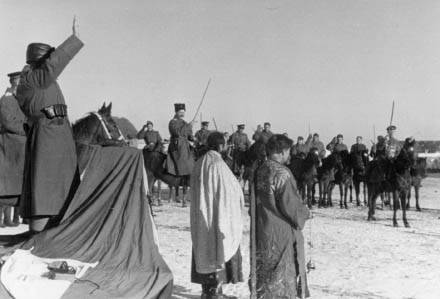 On the peninsula, Sergei Georgievich for some time served as the representative of the Kuban Cossack troops at the rate of the commander in chief. 25 June gathered in the Crimea Kuban regional Council elected him a military chieftain - at the head of the Kuban Cossacks, the first and only time in their history, came a native of the mountain peoples, Circassian Ulage!
On the peninsula, Sergei Georgievich for some time served as the representative of the Kuban Cossack troops at the rate of the commander in chief. 25 June gathered in the Crimea Kuban regional Council elected him a military chieftain - at the head of the Kuban Cossacks, the first and only time in their history, came a native of the mountain peoples, Circassian Ulage!But he himself seemed to be worried and worried least of all: Sergey Georgievich headlong was immersed in the preparation of a new military operation.
Landing on the Kuban
She entered the history called Ulagayevsky landing and was the last attempt of the White movement to change the course of the Civil War: one of the political goals of the landing was to raise an uprising in the Kuban regions, which could later spread to the Don.
On the military side, the first part of the landing operation was prepared and executed flawlessly. Having landed in the beginning of August at the village of Primorsko-Akhtarskaya, the Ulagaya detachments already reached the Popovichevskaya-Timashevskaya-Bryukhovetskaya line by the number of 5, inflicting a series of cruel defeats on the enemy. The Caucasian Cossack division of the Reds was utterly defeated, the chief of Meyer and his headquarters captured him, and the entire artillery of the division with a large quantity of ammunition was captured. On the same day, insurgents led by Colonel A. P. Skakun and Cossacks from the liberated villages of the total number of 2000 people joined the Ulagayevites. Everything seemed to go according to plan and develops as well as possible.
But then there were three days of marking time: Sergey Georgievich was waiting for the promised reinforcements from the Crimea, but he was not there. The Reds were not asleep - against the landing they pulled a powerful fist from one cavalry and two infantry divisions, three infantry brigades supported by three armored trains and two dozen armored cars. And on August 9, this whole armada fell upon the Ulagai troops.
With hard fighting Sergey Georgievich and his commanders led their troops to the coast. Even in these conditions, some of the village several times passed from hand to hand. And in the battle for Brynkovskaya, the Ulagaevites managed to capture more than 1000 prisoners and two dozen machine guns.
As they approached Primorsko-Akhtarskoye, the battles became increasingly tense: weapons and ammunition for Cossacks, who had to rise to fight with the Soviet authorities in the Kuban under the banner of Ulagai, were already unloaded in the village. But the mass action did not happen. And now the whites sought, by all means, to have time to evacuate these weapons back to the Crimea, and the red ones to seize.
To alleviate the fate of Ulagaya, the Wrangle departed the detachments of generals Kharlamov and Cherepov on Taman and near Novorossiysk, but they already had little to change in the fate of the landing force. The only thing that remained to Sergey Georgievich was to return to the peninsula with minimal losses. And the general succeeded. Even the Soviet military historian A. V. Golubev, who explored the last period of the Civil War without delay, noted in his writings, published at the end of 1929, that “in those August days, Ulagai firmly held control of his units in his hands and, despite a number of private defeats, did not allow the defeat of their main forces. This gave him the opportunity to systematically carry out a return evacuation to the Crimea, taking with him not only all his units, sick and wounded, but also about 12 thousands of mobilized, as well as prisoners of the Red Army. ”
Another confirmation that the landing operation of Ulagay was not a failure was the awarding of Sergey Georgievich 25 of August 1920 of the year to the highest award of the White Army - the Order of St. Nicholas of the 2 degree.
Forgotten by all
In the further defense of the Crimea Ulyagay did not play any significant role. Most likely because the large horse Cossack formations, headed by the general “was able to work wonders,” Wrangel no longer had.
After the Red Army took over the Perekop and Chongar fortifications in November 1920, Sergei Georgievich left the peninsula. First, he lived in the Kingdom of the CXS (Serbs, Croats, Slovenes, future Yugoslavia), where the remnants of some Kuban Cossack regiments were set up, and then he moved to Marseille.
Up to the beginning of the Great Patriotic War, the Soviet special services did not let Ulagai out of sight. And I must admit, the reasons for such close attention were more than enough.
It is known for certain that in 1922 – 1923 years, on the orders of Wrangel, Sergey Georgievich was preparing a new landing party on the Kuban and an uprising in the North Caucasus. For this purpose, the general traveled to Constantinople, where his contacts with representatives of the French and Turkish intelligence services were recorded.
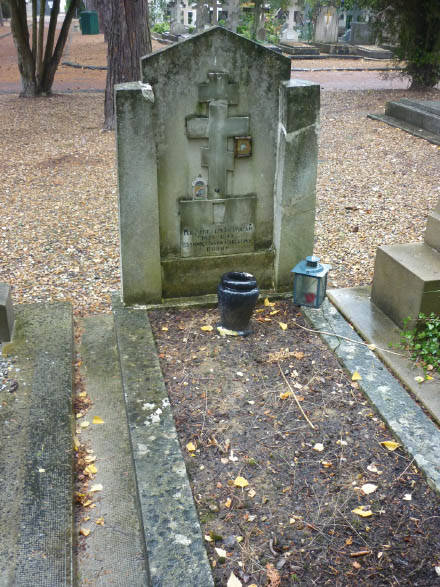 But the plans did not go further. Moreover, studying in detail the situation developing in the Kuban and the North Caucasus by the middle of the 1920-s, Ulagay came to the conclusion that any outside military intervention is doomed to failure in advance. What and reported to Wrangel, causing great displeasure of his boss.
But the plans did not go further. Moreover, studying in detail the situation developing in the Kuban and the North Caucasus by the middle of the 1920-s, Ulagay came to the conclusion that any outside military intervention is doomed to failure in advance. What and reported to Wrangel, causing great displeasure of his boss.After that, Sergey Georgievich gradually began to deviate from the activities of all the military organizations of the Russian emigration. For some time he was engaged in political work in the Gorsky monarchical center, headed by Prince Bekovich-Cherkassky. But when the French and Turks more and more actively began to push the Highlanders to unleash a terrorist war in Soviet Russia, and left.
The retired lieutenant-general had to earn something for bread. And Ulagay, since he didn’t know anything else, organized a circus troupe of mounted equestrians from the Kuban émigré Cossacks, with whom he toured extensively in Europe and America. The audience first died down in surprise, and then roared with delight, watching the Kuban people chew on the arena ...
At one time, in Soviet historical literature information was intensely exaggerated that General Ulagai played a decisive role in the military coup in Albania in 1928, and during the Great Patriotic War collaborated with the Wehrmacht and the SS, actively forming Cossack units to be sent to the Eastern Front.
All this has nothing to do with reality. The leading role during the coup in Albania was really played by Ulagay, but not Sergey Georgievich, but by his distant relative and namesake Kuchuk Kaspoletovich. By the beginning of the German attack on the USSR, the former hardcore cavalryman had already exceeded 65, and he was far from in the best physical shape. Therefore, the Nazi secret services did not even try to contact him at the beginning of the war against the Soviet Union. And then he was gone.
White-haired and forgotten by all the old man calmly survived the once turbulent life in Marseille and quietly went into another world 29 April 1944. In January, the 1949 of Sergey Georgievich Ulagay was transferred to the Russian cemetery of Saint-Genevieve-des-Bois near Paris.
The burial place of the general every year becomes more and more neglected. Perhaps the grave with the inscription "Eternal glory to the Russian soldier" will soon disappear completely ...
Information